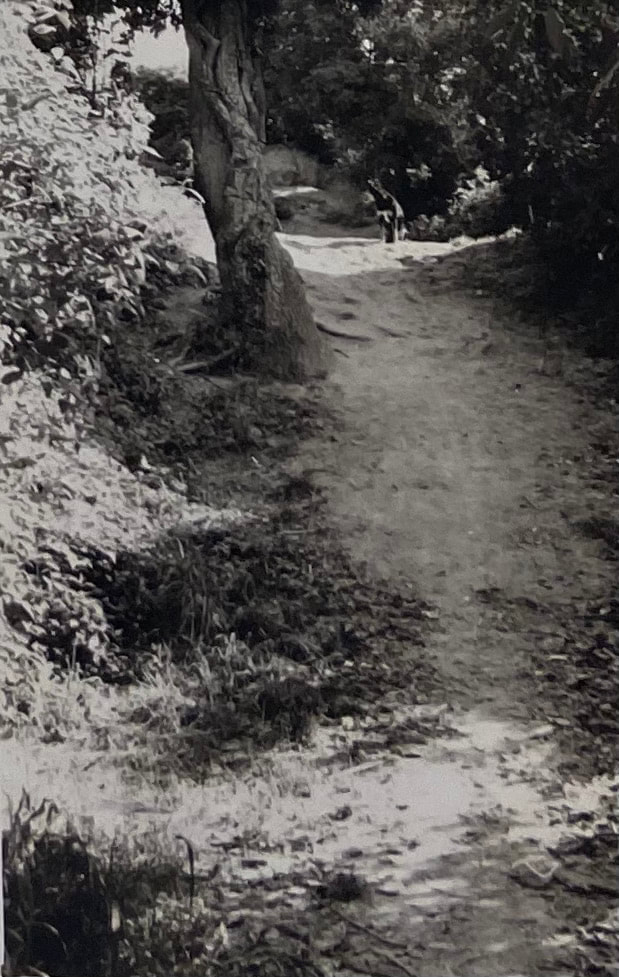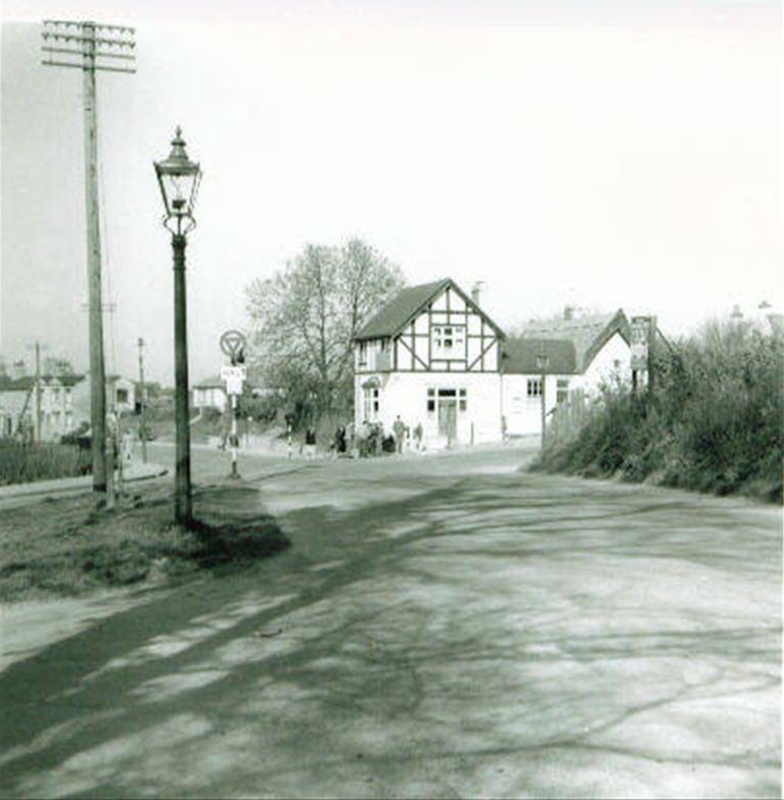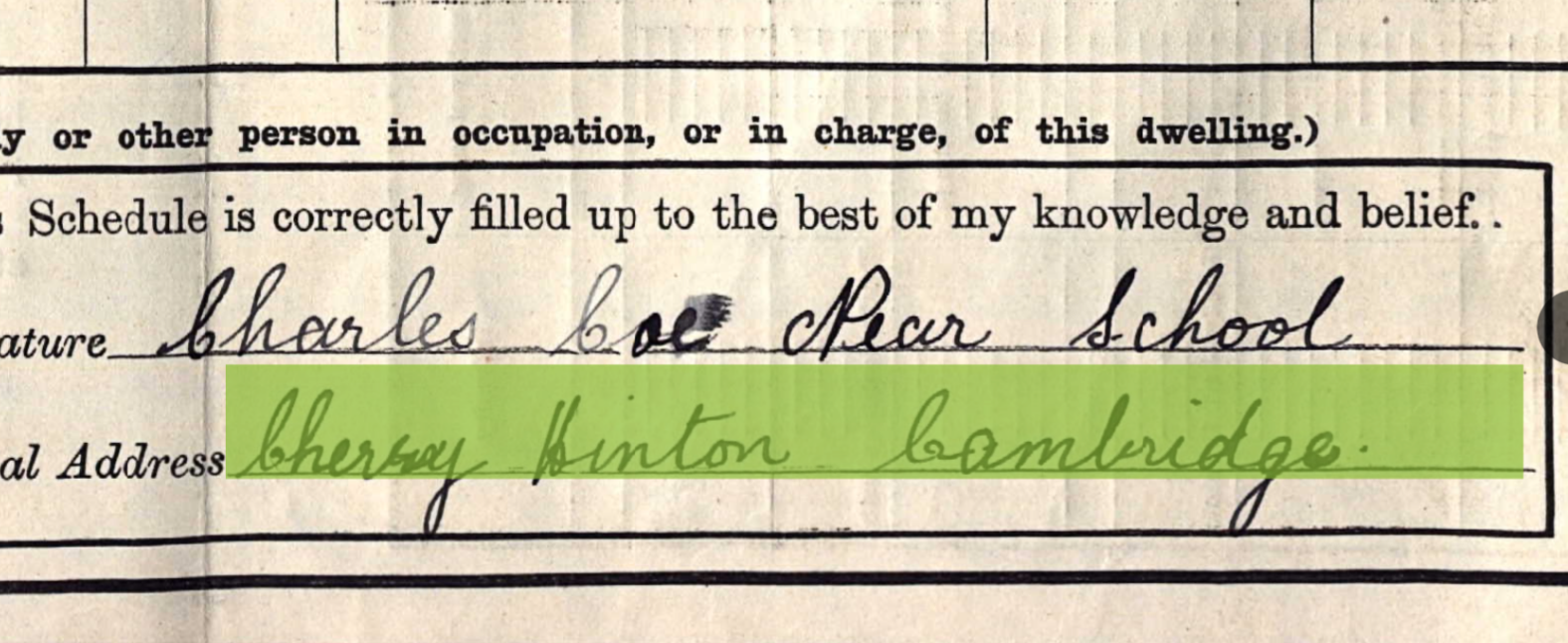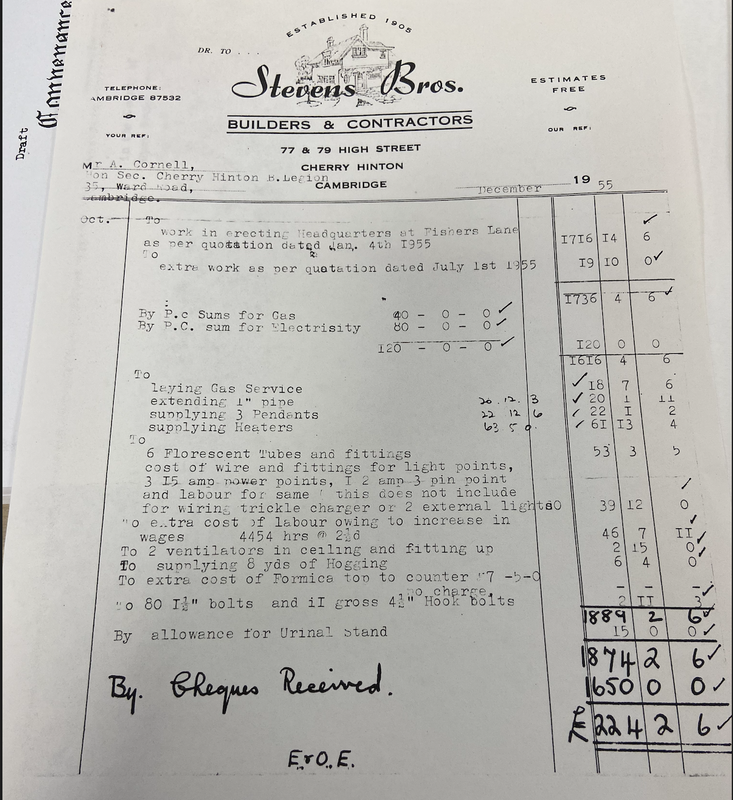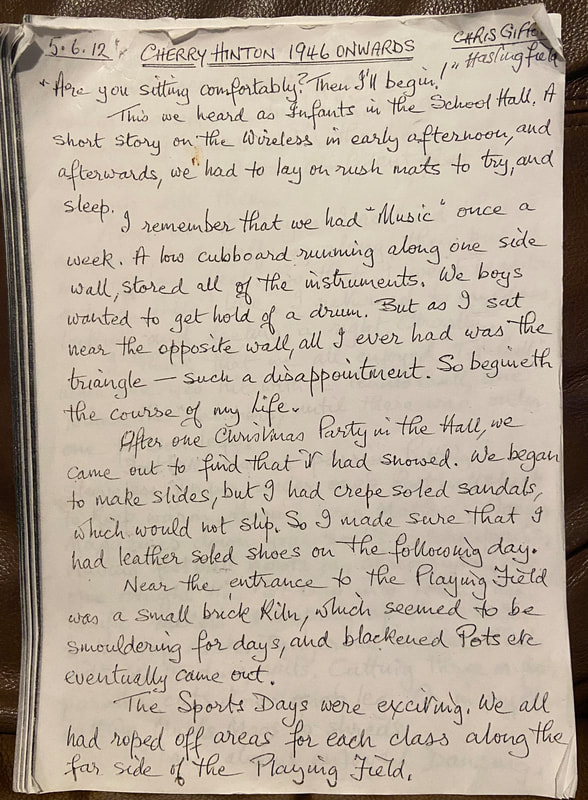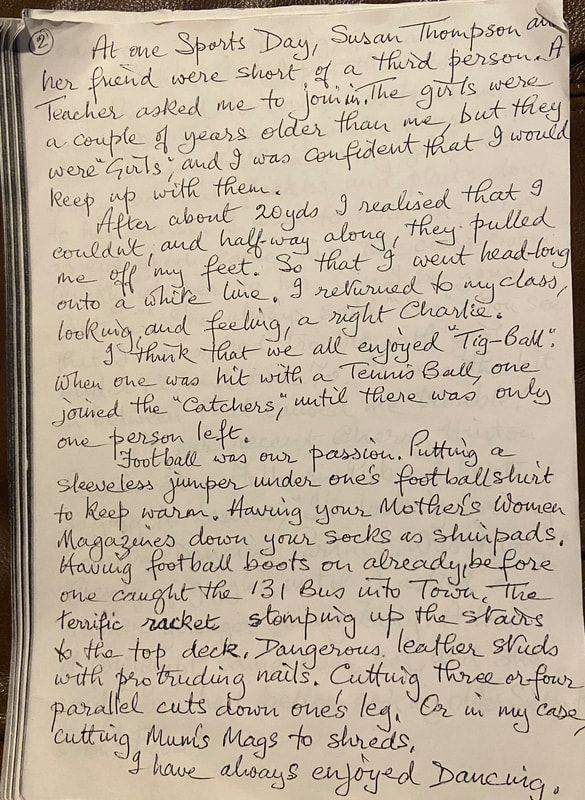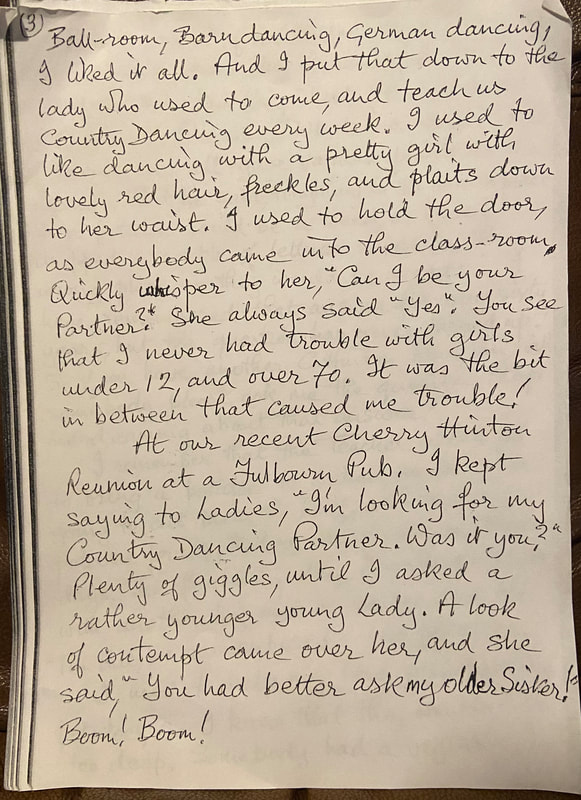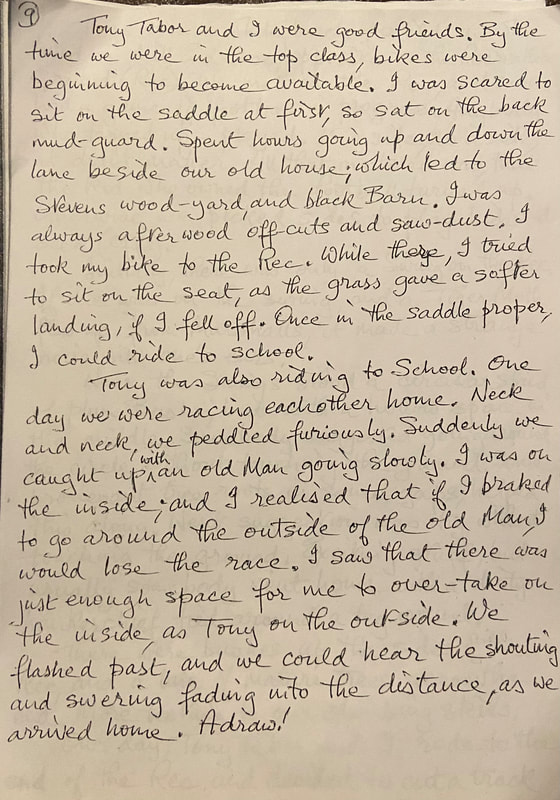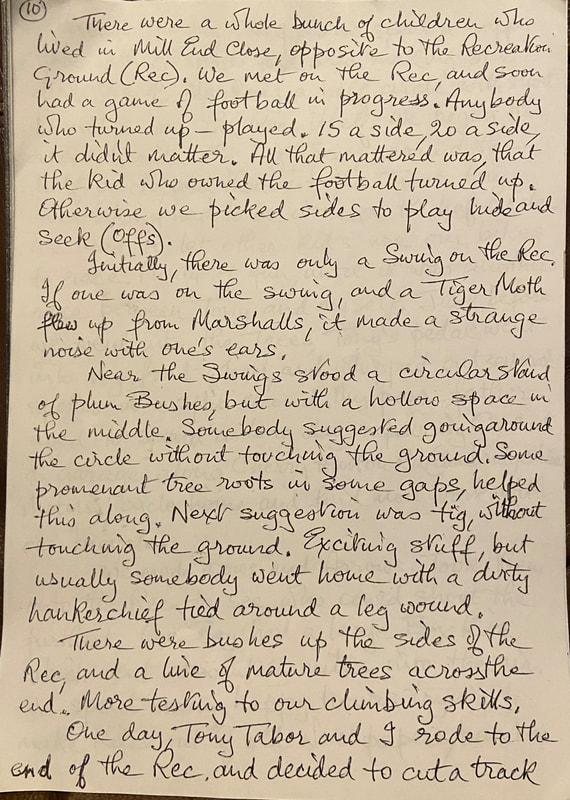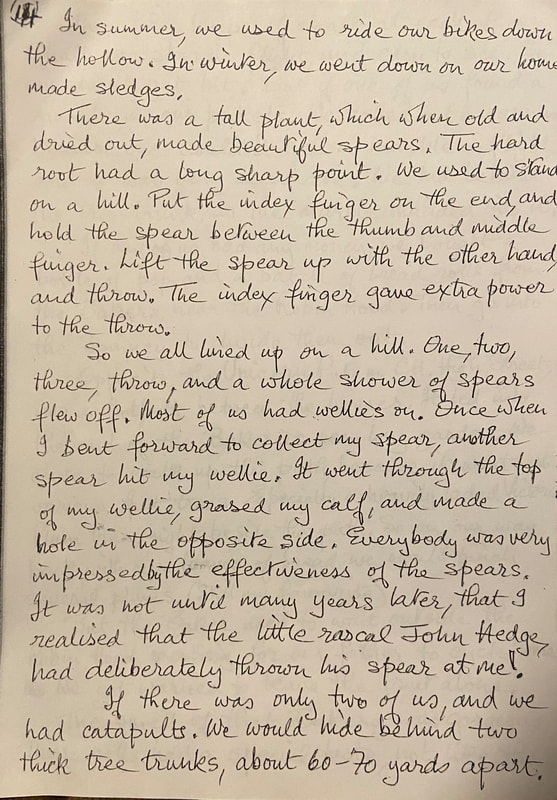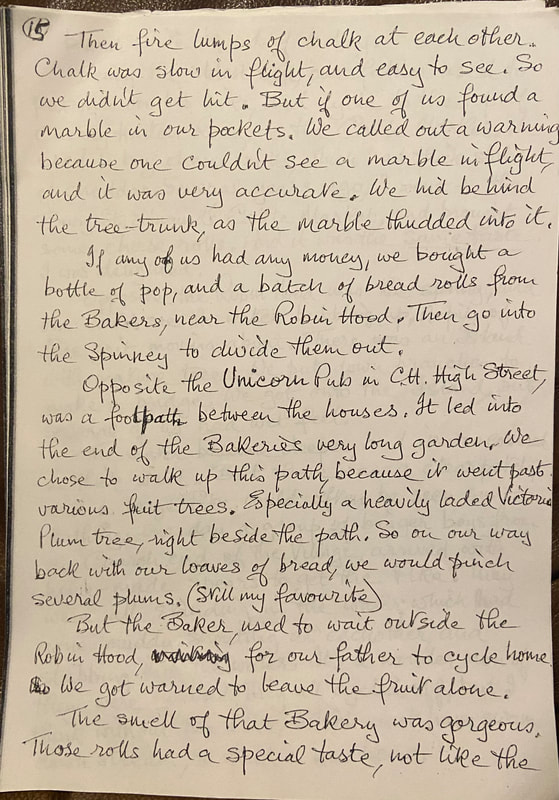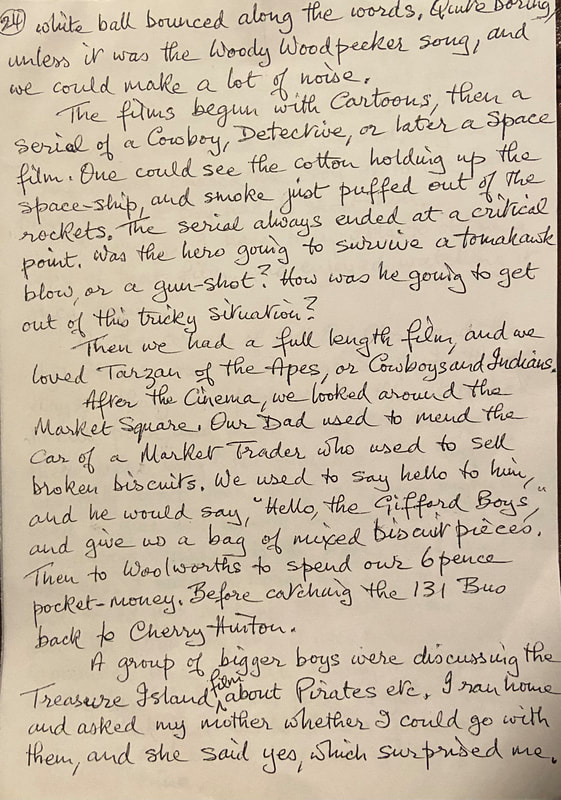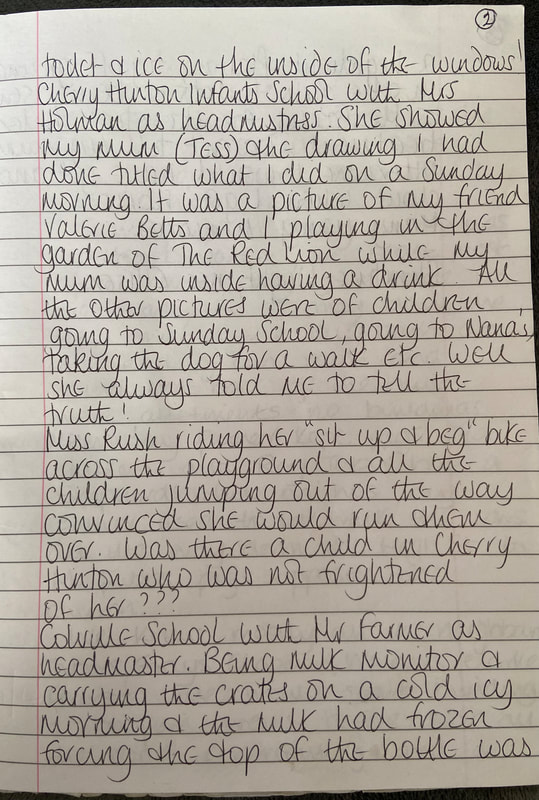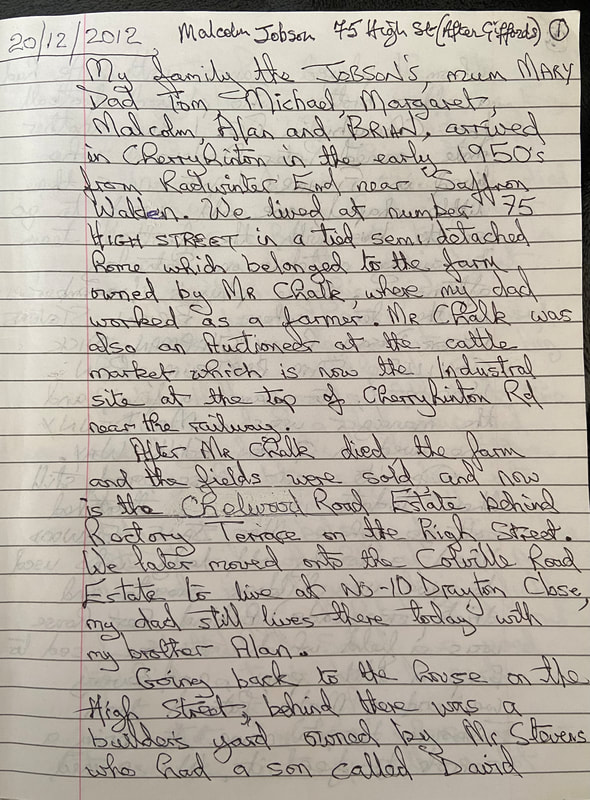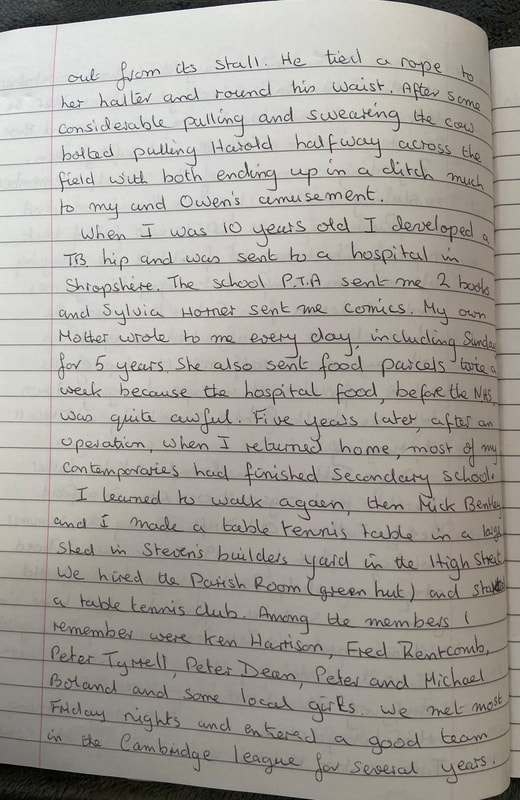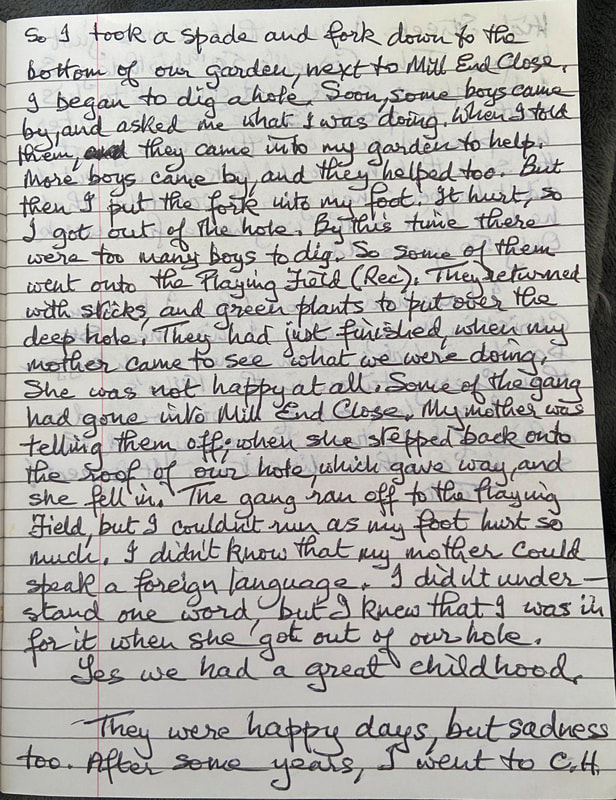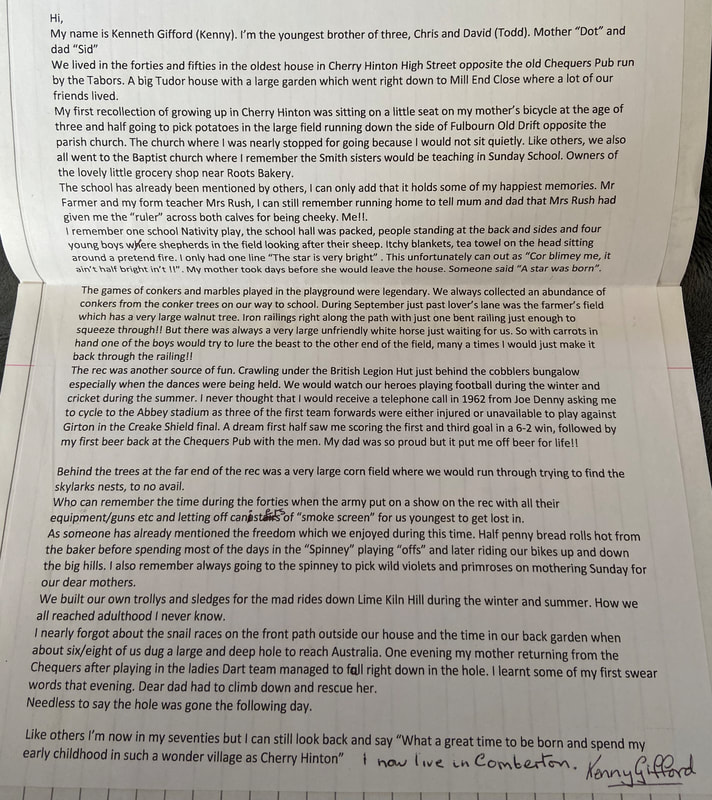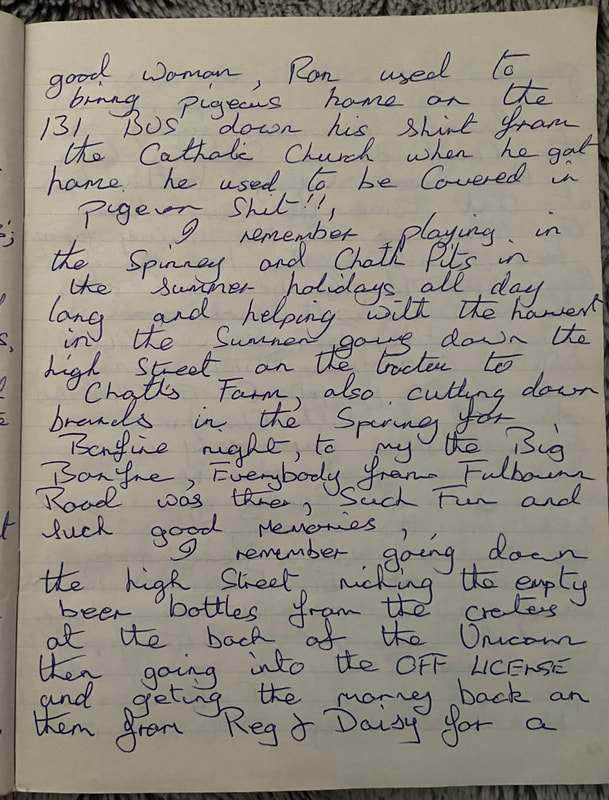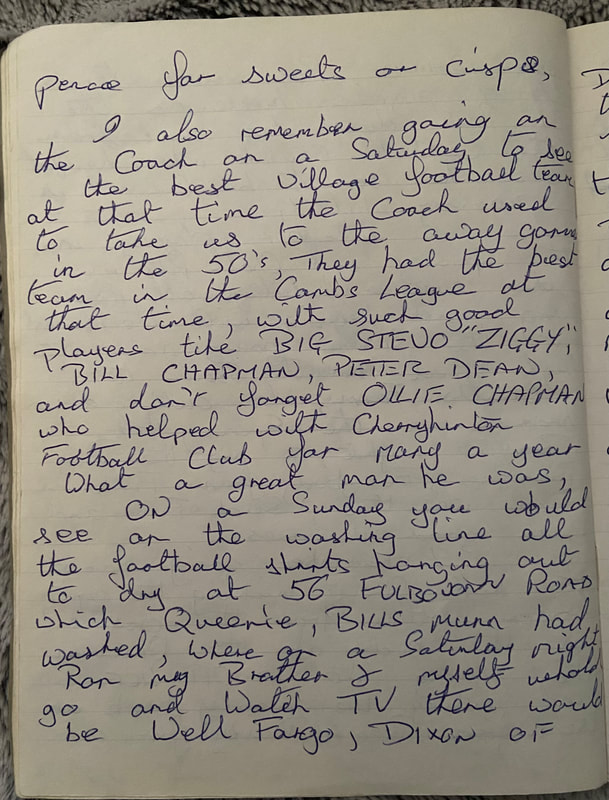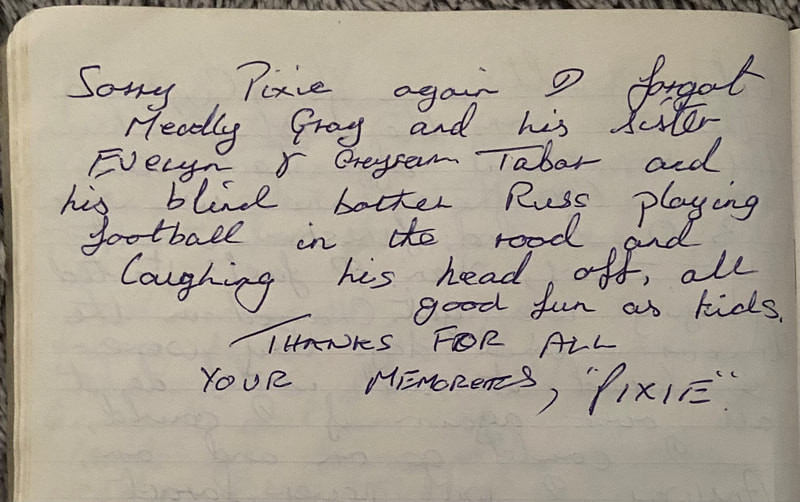|
This memory is taken from the Cherry Hinton Memory Books Collection which were donated to my Cherry Hinton archive. You can read more about the complete collection by clicking here:
Cherry Hinton Memory Books Introduction I am now taking each memory/story and posting them individually on here, adding in any pictures to illustrate the memories and any further points of information and research that may be of interest.
Memories of Cherry Hinton by Bryan Stevens
Vic Phillips often mentions me by my nickname “Ziggy”. Ziggy was the owner of the clothes shop in Newmarket Road before he moved into Regent Street “Stylebest”. This shop sold the most modern clothing during the fifties and sixties and it was where I bought most of my clothing, hence the name “Ziggy”. Ziggy gave me a gold tie pin for my wedding in 1959 which I still have. I am now happily married for the second time.
Bonfire nights in the High Street were something special. There was an air raid shelter opposite 197 High Street, where I used to live, and we would fill it up with logs collected from the Spinney. One Bonfire night the fire was so large that it nearly burnt down the telephone wires.
There was a rubbish dump down Fulbourn Old Drift over the railway line and we would go up there with our air rifles to shoot the rats. One day we were up there shooting the rats when the siren sounded from Fulbourn Hospital and thinking someone had escaped we all ran home as fast as we could.
We all talk about the Spinney with fond memories. During the school summer holidays we more or less lived up there, making dens, laying turf for the floor of the den, and cooking on open fires. One day when we were there my dog Gyp caught two rabbits from out of the chalk pits which I took home.
Opposite the Robin Hood pub are the springs where the water for the brook starts. There used to be railings round the springs to try and keep us out but we would get in and try to catch the pike which would be by the island. We would stand on the now stepping stones and try to catch them before they went back to the lake in Cherry Hinton Hall.
In the brook round by the Black Land allotments we would block up the tunnel underneath the bridge with a sheet of corrugated iron so that the water could not escape and we could get it deep enough to swim.
Grandma Coe who used to live at the then 203 High Street was still riding her “sit up and beg” bike when she was 90 years old. I still remember when a horse and cart passed by her house and left “deposits”, she would rush out with a bucket and collect them. She always had the best roses in the High Street.
As you old Hintonians know, my grandfather started the Stevens Brothers Building Company. He built some of the first houses for the Housing Association in Cambridge. One of the last houses they built was the bungalow in the High Street for the Bartram family (the level crossing keepers). They also built the shoe repairers bungalow next to the recreation ground.
The Cherry Hinton History Society have no record of the building company. My only record is a photograph of a cast iron sewage drain cover in the front garden of the house in the High Street which used to be 201 High Street. It reads “Stevens Bros, Builders, Cherry Hinton”. If anyone could help me find out any other information I would be grateful.
Further notes by Michelle:
I would love to find that drain cover, mentioned above, and get a picture of it and photographs of where the houses above mentioned stood. I have had a look along that stretch of High Street but the house numbers have all changed sometime ago and many houses have been pulled down and others built in turn. There is a real challenge now to draw up a map showing the changing houses/buildings and where they were over time on the High Street, along with working out the house numbering system. Once this has been done we will be able to add the information and pictures to a separate article, and in turn to these memories where they mention any particular houses.
One clue from the story above is that Mrs Coe lived at what was then 203 High Street - meaning that 201 would perhaps of been next door to that house, and therefore the Steven Bros drain cover may still be found somewhere there.
I have search the census, electoral and directory information to see if I can find which house Mrs Coe lived at on the High Street around the 1930's-1960's. The only two clues that I have so far are the picture on the left below, which is from the Richard Hoye collection - it is a photograph c.1985 showing a house on the High Street which is still there today (see my picture on the right). Richard Hoye's picture, on the left, has a note beneath it stating "Mrs Coe". The house has the name 'Temperance Villa' on it (for which I have searched many records and turned up nothing on it) and it is dated 1903. If this was the house, 203 High Street, referred to in the story above it is now known by a different number.
The next clue is on the 1911 Census and of the only Coe family on the High Street at that date - it shows Charles Coe living on the High Street with his family "near the school" - Temperance Villa shown above would have been built by this time - and is near the school on the High Street. This branch of the Coe family were certainly living along this stretch of the High Street in 1911, did one of these Coe ladies end up living in Temperance Villa and is this the house referred to above, what was then 203?
We might also be able to work out where 197 High Street, above mentioned, was and in turn know that across the road there was once an air-raid shelter - which may or may not remain in some form.
I have managed to find out a little more about the Steven's Bros Builders business. The picture below shows Albert Stevens and Jess Tabor in Cherry Hinton near the railway line, stating that they are both apprentice carpenters. The photo is not dated but as you will see from the other sources that I've managed to find, below, this helps us get an idea of what the Steven's Bros were doing in their business.
You can see from the County Directory extract below that 'Stevens Brothers' are listed as builders and wheel-wrights.
Then, in this newspaper clipping below from 1936, we find that the Stevens Bros were the undertakers of a funeral! They give the address for the business as the High Street Cherry Hinton. As odd as this seems, to find them acting as undertakers, this was not unusual for joiners or furniture makers and like to do this at this time. I presume it would be because they are able to produce the wooden coffins but that's just my guess as to why this is the case, as in many similar firms across the country years ago - in fact Chippendale in London, the great furniture maker, also did the same, so it really was 'a thing'.
To add further proof that they were listed as builders and contractors but also carrying out undertaker services, you can see more detail on the bill below from 1935. Note the business header on this paper and the house shown.
 Stevens Bros Builder & Contractors Cherry Hinton. Bill for Undertaker services - CHCAN Donated by Neville Cullup Stevens Bros Builder & Contractors Cherry Hinton. Bill for Undertaker services - CHCAN Donated by Neville Cullup
You can see the details of the business still continuing in 1955 from the newspaper advert below.
 Cambridge Daily News September 24th 1955 - British Newspaper Archive Cambridge Daily News September 24th 1955 - British Newspaper Archive
A very important part of the village has been the British Legion Hall, first a shed-like building that once stood on the main recreation ground and then, when it was rebuilt down Fishers Lane. So many Cherry Hinton memories from both of these two versions of the hall from over the years. The Fishers Lane hall was demolished about 10 years ago and now the houses of Poppy Close stand on its site. I have now discovered that the Stevens Bros were the builders for the British Legion Hut in Fishers Lane, as you'll see from the bill below. This is great to discover and will add a bit more to the story of the firm. Again note the header and picture of the house. They give their address as 77 & 79 High Street Cherry Hinton.
 The second British Legion Hut, Fishers Lane Cherry Hinton c.1985 - R.Hoye, courtesy of Cambridgeshire Collection The second British Legion Hut, Fishers Lane Cherry Hinton c.1985 - R.Hoye, courtesy of Cambridgeshire Collection
The picture above shows the Fishers Lane, British Legion Hall, as it was, built by the Stevens Brothers of Cherry Hinton.
Please do feel free to get in touch if you would like to add anything to this story or if you have any further information on the Stevens Bros.
If you'd like to support the work that I do and the archive, why not buy me a virtual coffee, I'd be really grateful and it will help keep me going!
Just click on the green button below :)
2 Comments
Here you will find the complete article by Chris Gifford 'Cherry Hinton 1946 Onwards' - if you haven't done so already, I would encourage you to take a brief look at the introduction page about the memory books and this accompanying article first - which you can do by clicking the link here: Cherry Hinton Memory Books - Introduction
There are three books altogether and this one separately written article - you can find the links to the other books and this article by visiting the Cherry Hinton Memory Books Introduction page, mentioned above, or by searching the index (Categories) on the righthand side of this page or by using the search box on the right.
Cherry Hinton 1946 Onwards Chris Gifford 5.6.12
Chris Gifford Cherry Hinton Memories
“Are you sitting comfortably? Then I’ll begin!” This we heard as infants in the school hall. A short story on the wireless in early afternoon, and afterwards, we had to lay on rush mats to try and sleep. I remember that we had “Music” once a week. A low cupboard running down along one side wall, stored all of the instruments. We boys wanted to get hold of a drum. But as I sat near the opposite wall, all I ever had was the triangle – such a disappointment. So begineth the course for my life. After one Christmas Party in the Hall, we came out to find that it had snowed. We began to make slides, but I had crepe soled sandals which would not slip. So, I made sure that I had leather soled shoes on the following day. Near the entrance to the Playing Field was a small brick kiln, which seemed to be smouldering for days and blackened Pots etc eventually came out. The Sports Days were exciting. We all had roped off areas for each class along the far side of the Playing Field. At one Sports Day, Susan Thompson and her friend were short of a third person. A teacher asked me to join in. The girls were a couple of years older than me, but they were ‘girls’, and I was confident that I would keep up with them. After about 20yards I realised that I couldn’t, and half-way along, they pulled me off my feet. So that I went head-long onto a white line. I returned to my class, looking, and feeling, a right Charlie. I think that we all enjoyed “Tig-Ball”, when one was hit with a tennis ball, one joined the “catchers”, until there was only one person left. Football was our passion. Putting a sleeveless jumper under one’s football shirt to keep warm. Having your mother’s women magazines down your socks as shinpads. Having football boots on already, before one caught the 131 Bus into town. The terrific racket stamping up the stairs to the top deck. Dangerous leather studs with protruding nails. Cutting three or four parallel cuts down one’s leg. Or in my case cutting mums mags to shreds. I have always enjoyed dancing. Ballroom, Barn dancing, German dancing, I liked it all. And I put that down to the lady who used to come and teach us Country Dancing every week. I used to like dancing with a pretty girl with lovely red hair, freckles, and plaits down to her waist. I used to hold the door, as everybody came into the classroom. Quickly whisper to her, “Can I be your partner?” She always said “Yes”. You see that I never had trouble with girls under 12, and over 70. It was the bit in-between that caused me trouble! At our recent Cherry Hinton Reunion at a Fulbourn Pub. I kept saying to ladies, “I’m looking for my Country Dancing partner. Was it you?”. Plenty of giggles, until I asked a rather younger young lady. A look of contempt came over her, and she said, “You had better ask my older sisters!” Boom! Boom! It was clever of our Headmaster to play some classical music at morning Assembly. I liked “The Hall of Mountain King” best. He used to ask us questions. One was, “What is a weed?” And of course, we all gave various plants as the answer. But he said, “Anything in the wrong place. So, a potato could be a weed, or if one dropped a couple of lettuce seeds in the wrong place – they would be weeds.” I have remembered that answer for over sixty years, but the question has never turned up! So, if we have another C. Hinton Reunion, will somebody please ask me the question. Stop me dreaming about that answer! I remember that the teacher asked us to bring a potato to school, as we were going to cut them in half, and make potato prints. Modern ideas even in those days. The following day, I walked to school with another boy, and as we reached the Tin Hut, we remembered – no potatoes. I used to help my dad with planting potatoes, so I knew that they wouldn’t be too deep. Somebody had a vegetable patch between the railway line path and the playground boundary. I told my friend to keep an eye out. Took a stick, ran over to the potatoes, and quickly dug two out. Of course, all afternoon, I was waiting for the headmaster to come into our class, but nothing happened. Another time, the headmaster asked me to take a bundle of old letters to the Vicarage. The stamp on the top of the letters was Queen Victoria. Many of us collected stamps in those days. I kept looking at that stamp, and I gave into temptation, and ripped the corner off that envelope. (Even in later life, I was prone to give in to temptation – not stealing, unless it was a cherry). Then I thought, I’m going to get “told off” for taking one stamp, I might as well have more. I worried about it at the time, but nothing happened. I remember a Vicarage Fete, and they had a painting competition at 6 pence per entry. I did a vase of flowers. A blue vase with some red crosses on it. John and Peter Hedge and their mother were going to the fete. I tagged on with them. The winning entries were pinned up on display boards. There was my painting, but with a girl’s name on it. I told Mrs Hedge, and she went over to tell them the mistake. When the prizes were given out, I was given two fairy cakes worth 6 pence. Disappointed Tunbridge Wells! I never went in for anymore painting competitions. “Turf” cigarettes had printed cards onto the packaging. So, as we walked to and from school, little Eagle Eyes were on the lookout for old ‘Turf’ packets. Brian and Tony Tabor, as they lived at the Chequers Pub, suddenly cornered the market. They came to school with packets full of Turf cigarette cards. The dear boys had emptied out all of the Turf cigarettes and taken the packets. After which, customers were given their cigarettes in small paper bags. Then dad had some pigs down the end of the garden and took some farming magazines. So, when our teacher asked us to look out for pictures of farmyard animals. Tony arrived for school with a whole pile of magazines and gave them out. But there were only a few pairs of scissors, and I became tired of waiting, so ripped out the various pictures. Pasted them in my book, job done. But the teacher was not impressed. This was while in the Tin Hut. The teachers had a chart on the wall to record Tables. One had to say the table and then answer some questions, i.e. what is 7 x 3? 9 x 3? Etc etc. Success meant a star against your name. I struggled to get 2 stars, while some children had 5 or 6 stars. I had forgotten that we had poetry and we had to write out the poems into our books. The neatest one got a prize. We boys discussed the prize as we walked home and decided that it must be a penknife! I won the prize, and it was a book of children’s poetry by R.L. Stephenson! Deep depression as we walked home. A poetry book of all things. Some weeks later in Assembly, the Headmaster asked a question to which the answer was R.L. Stephenson. Nobody knew the answer. He said, “I’m surprised that Chris Gifford didn’t know the answer, after winning that book of poetry by R.L. Stephenson”. Of course, I went as red as a beetroot, having not even opened the book. Last year at the Trumpington car boot, I brought a copy, thinking that I would actually read it after 60 years. But I mislaid it somewhere in my house. Sorry! Mr Stevenson. We were writing with the simple nib pens and had to keep dipping the pens into the ink. When we came out of school one afternoon, a man was sitting outside the Tin Hut with a board of colourful fountain pens. They had wooden bodies. He said that if we brought him a bag of old clothes, we could get a pen. I ran home and got a bag of clothes. My mother being in Town. But he said that these weren’t enough, so I had to run home again, grab my dad’s old pullover and an old jacket, run back again. This time I was given a pen. The next morning in class a lot of us were writing with our bright, new pens. Tony Tabor and I were good friends. By the time we were in the top class, bikes were beginning to become available. I was scared to sit on the saddle at first, so sat on the back mud guard. Spent hours going up and down the lane beside our old house, which led to the Stevens wood-yard and black barn. I was always after wood off-cuts and saw-dust. I took my bike to the Rec. Whilst there, I tried to sit on the seat, as the grass gave a softer landing, if I fell off. Once in the saddle proper I could ride to school. Tony was also riding to school. One day we were racing each other home. Neck and neck, we peddled furiously. Suddenly we caught up with an old man going slowly. I was on the inside and I realised that if I braked to go around the outside of the old man, I would lose the race. I saw that there was just enough space for me to over-take on the inside as Tony on the out-side. We flashed past, and we could hear the shouting and swearing fading into the distance, as we arrived home. A draw! There were a whole bunch of children who lived in Mill End Close, opposite to the Recreation Ground (Rec). We met on the Rec and soon had a game of football in progress. Anybody who turned up – played. 15 a side, 20 a side, it didn’t matter. All that mattered was that the kid who owned the football turned up. Otherwise, we picked sides to play hide and seek (offs). Initially, there was only a swing on the Rec. If one was on the swing, and a Tiger Moth flew up from Marshalls, it made a strange noise with one’s ears. Near the swings stood a circular stand of plum bushes, but with a hollow space in the middle. Somebody suggested going around the circle without touching the ground. Some promenade tree roots in some gaps helped this along. Next suggestion was tig, without touching the ground. Exciting stuff, but usually somebody went home with a dirty handkerchief tied around a leg wound. There were bushes up the sides of the Rec and a line of mature trees across the end. More testing to our climbing skills. One day, Tony Tabor and I rode to the end of the Rec and decided to cut a track through the big trees. So, we spent a happy time with a spade and saw making our dirt track. Making a half circle with short branches on the Rec itself. We began the races beside the big trees, around the half-circle, and then to the trees. Any over-taking had to be done on the half-circle. We used to let other kids use our bikes to race. Plenty of fun, until it was another race between Tony and myself. Just before we went into the trees, Tony’s pedal went into my front wheel, and whipped out several spokes in a split second. My poor father used to spend a long day repairing cars at a garage along Cherry Hinton Road (Cambridgeshire Motors), cycle home, and find more work with our bicycles. We made bows and arrows. Took then onto the Rec to see who could shoot the furthest. One boy had a large box kite, which went absolutely miles into the air. We spent many happy hours trying to make kites out of old newspapers, bamboo strips, glue, paint and string. We had to run at 50 miles an hour just to get those kites up in the air a bit. Catapults were another obsession. As we wondered about, we always kept a good eye out for suitable wooden forks in a “Y’ shape. I found a red car wheel innertube in my dad’s garage. “Borrowed” my mum’s scissors and cut off strips for catapults. I think that nearly every kid in the area, turned up for a pair of red rubber strips. At the end of the Rec was usually a corn field, and we enjoyed making tracks and hiding places in it. Until the farmer sent the local Copper to tell us off. I remember lovely summer evenings when we were all having great fun and our mother coming to the Rec to call us Gifford three in for bed. Looking at the older kids, who were allowed to stay out. There are photos of my father as part of the Chequers Darts Team, in cricket whites in the Cherry Hinton Team, and he was in the Football Team. After he married, he didn’t have the time for any of it – which is sad. Our place of joy was the Spinney. A wild place of small hills and a deep hollow, thick with bushes and some mature trees. To have such a place at one end of the village, opposite the “Robin Hood” pub was brilliant. We used to gather on the Rec. Divide into two teams. One side would dash up to the Spinney to hide, while the other side counted up to 500 (nothing wrong with our village education!). Whoever was caught had to join the Seekers, until only one or two were left. Not being able to find them, sometimes we called out “We are going home!” and all troop out of the entrance. But then creep around the edges, waiting for movement. Then all poured in to give chase. My middle brother Dave (Todd) was extremely cunning at hiding. Once he sat in the middle of a creeper covered bush right beside a footpath. Another time, he climbed a tree and lay on an Ivy-covered branch, going over a footpath. So, we all passed by, underneath him. I once sat under a bush, only to be entertained by a little mouse fussing about. In summer, we used to ride our bikes down the hollow. In winter, we went down on our home-made sledges. There was a tall plant, which when old and dried out, made beautiful spears. The hard root had a long sharp point. We used to stand on a hill. Put the index finger on the end and hold the spear between the thumb and middle finger. Lift the spear up with the other hand, and throw. So, we all lined up on a hill. One, two, three, throw, and a whole shower of spears flew off. Most of us had wellies on. Once when I bent forward to collect my spear, another spear hit my wellie. It went through the top of my wellie, grazed my calf, and made a hole in the opposite side. Everybody was very impressed by the effectiveness of the spears. It was not until many years later, that I realised that the little rascal John Hedge, had deliberately thrown his spear at me! If there were only two of us and we had catapults, we would hide behind two thick tree trunks, about 60-70 yards apart. Then fire lumps of chalk at each other. Chalk was slow in flight and easy to see. So, we didn’t get hit. But if one of us found a marble in our pockets, we called out a warning because one couldn’t see a marble in flight, and it was very accurate. We hid behind the tree trunk, as the marble thudded into it. If any of us had any money, we bought a bottle of pop, and a batch of bread rolls from the bakers, near the Robin Hood. Then go into the Spinney to divide them out. Opposite the Unicorn Pub in C.H. High Street, was a footpath between the houses. It led into the end of the Bakeries very long garden. We chose to walk up this path, because it went past various fruit trees. Especially a heavily loaded Victoria Plumb tree, right beside the path. So, on our way back with our loafs of bread, we would pinch several plumbs. (Still my favourite). But the baker used to wait outside the Robin Hood, for our father to cycle home, we got warned to leave the fruit alone. The smell of that Bakery was gorgeous. Those rolls had a special taste, not like the bland white bread of today. Being the eldest son, our father used to put me on his bike, and cycle to the top of Cherry Hinton Road, to the Cattle Market. He used to buy cheese roll, which had thick slabs of cheddar. Several years ago, I went to the Bury St. Edmunds Cattle Market, and brought some cheese rolls and it was the same taste. I was delighted. Opposite the Robin Hood was the spring, and one could see the water bubbling up, a pile of fine grit moving about. There was an island with mature trees. We put down branches to make a bridge. We got onto the island but several of us had wet feet. The water became deeper, and it was covered in thick weed. But there was a clear patch, and a large Pike could often be seen sun-bathing. One day a group of bigger boys from the Church End of the village, arrived with home-made spears to get the Pike. They were all standing in the water, which had gone muddy, shouting at each other and stabbing the water. It’s a wonder none of them were injured. They all cycled off, but I think, without the Pike, which must have swam downstream to find a new home. At the other end of the spring was a high black metal fence. But we could get our feet between the uprights and walk over to the other side. There was a large meadow, and the stream went on to Cherry Hinton Hall. At the time the Hall was in private hands. The back of the Hall was an overgrown jungle. So, we could follow the stream along and into this brilliant place. If we made too much noise, there was always the possibility of being chased by one of the gardeners. I remember one sunny day, and we were following a track through the jungle. I climbed onto a thick fallen tree trunk and was just about to jump down, when in a patch of sunlight lay two grass snakes. I yelled “Snakes”, and we all ran off in panic. Us little boys had never seen snakes before and were easily scared. There was another set of black metal fencing at the other side of the C. H. Hall, which we could easily climb around and come out at the Brook and allotments. So, we could return home along Mill End Lane. We spent hours and hours down at the Brook, catching sticklebacks. Most of them were 3 spine but occasionally we caught a black 10 spine fish. Usually, it was my brother Dave who caught the 10 spine fish, as he went down the stream of the Wooden Bridge, and just used his hands to catch fish. Further down-stream, where it was too deep to paddle, we had some thread and a cane, tied on a small nut for a weight and a small worm. The bigger sticklebacks would take in the end of the worm, and we would gently pull them out. Sometimes they dropped off but in the Brook. We lived in the “Red House”, which was a pair of old red brick semi’s, belonging to the Church. We were on the High Street, opposite the Chequers, and the Thatched Cottage. It was only a one room up and one down. Very dark inside, and dark twisting stairs. We had gas lights and had to go “over the yard” to an old wooden hut privy. Dad had a large shed next door, where he had a vice, tools, and car parts, as he was a mechanic by trade. By watching him in his shed, we learnt about the various tools and how to use them. We used to make our own trolleys, fishing rods, and sledges etc. Although we left his tools all over the place, I think dad was quite proud of our efforts. One day, Billy Taylor and I were looking around in dads shed. Billy picked up a strange box with a plunger on top. Pressed the plunger and it made a horrible noise. It was a horn from an old 1920’s Taxi. Beside the Thatched Cottage, on the other side of the road, was a large meadow going down to Fishers Lane. The farmer kept a mixture of white bull, cows, and a couple of horses, all in together. We sat on top of the wooden rails and took it in turn to press the plunger. Weerrker! Weerrker! Weerrker! The animals began to run I a group around the meadow. Weerrker! Weerrker! Weerrker! More and more noise. Faster and faster went the animals, until it was like a wild west stampede. They were thundering around. While at the Fishers Lane end, the white bull disappeared right through the hedge. We ran into the middle of the road and looking anxiously to see what would happen. Suddenly, the white bull appeared, coming straight down the middle of the road towards us. We immediately ran for my dad’s shed, and looked out from the doorway, as the bull went past. We stood in the middle of the road again and watched the bull going up towards the Robin Hood. Sometime later, back came the bull with a man on a bike guiding him home. Back in the shed again. A lot of excitement and we got away with it completely. The next house along was a big house made out of chalk/clunch, most probably from the Spinney. There was a long barn at right angles to the house, and a tall pole, which could have been a wireless Ham Radio. Every evening a little owl sat on top of that pole and screeched. Beside the chalk house was a footpath going to Mill End Lane, and so was our short-cut to the Brook. One side of the footpath were trees and bushes, and on the otherside a large meadow with a tall pear tree and a carthorse. The pears were small, red/yellow and sweet. The ripe ones dropped onto the grass, and we would go over the fence, run out to the tree, picking up as many as we could, stuffing them down our shirts. But the carthorse didn’t like us in his meadow, and always chased us out. So, some of us lads went to the Mill End Lane end of the meadow, The horse gave chase, as we others went in for the pears. As soon as he saw us at the tree, he came charging up. But we already had our fruit. For us boys, the best place in the world was Woolworths. They sold what we wanted. Foreign stamps, balsa wood gliders, marbles, and fishing kit. Brilliant. Brian and Johnny Richardson lived on Coldhams Lane, and they had the Cement Works pit beside them. A real source of adventure. Their father took them on bikes right to the end of Coldhams Lane, over Newmarket Road, past the Gas Works and to the River Cam. So instead of sticklebacks, they were catching Gudgeon, Roach, and Perch. Huge monsters in comparison. They told us lads at school and got us all excited. Woolworths sold a beginner’s kit of line, float, weight and hook on a card. Dad got a piece of 1” square board, knocked in some staples, and nailed on a cotton reel, so I could wind on the line, and fix the hook to the staple. Dad found an empty paint tin, and a piece of white bread. Ready. From the Chequers, I cycled up to Coldhams Lane and met Brian and Johnny. That first time seemed a long cycle ride. Too much anticipation I suppose. Soon we were beside the river, and I watched what they were doing. Put my float up to fish close to the bottom. Gudgen shoal on the bottom and bite freely. So, it’s only a couple of minutes before one of us has a bite and swings in a sturdy fish. We only had to fish 3” or 4” from the bank, so it was easy fishing. Time goes by quickly when you are having fun. We gradually moved upstream until we came to the Jesus Green Weir, and that became our favourite place. Fishing became one of our main hobbies. We three Gifford brothers always took our rods in the car, whenever dad took us out. Even coming back from a Hunstanton seaside trip, the rods were with us. Halfway back home he always stopped at an isolated pub right beside the river (A10). We caught some lovely silver bream, another new species for us. Dad always came along with glasses of pop and crisps. We didn’t mind how long our parents were chatting in the pub, and it was always disappointing to have to stop fishing. Brian Richardson became a very accomplished fisherman. After about 50 years I was able to obtain his phone number and we are going to meet up and have a go at fishing again. And of course, it will give us a chance to chat about our childhoods. There was no T.V. when we were young. The Victoria Cinema on the Market Square used to run Sat morning films for us children. The “minors” had a membership card, and sometimes checked the cards at our back of the cinema entrance, beside the Holy Trinity Church. The Mark’s & Spencer shop is now on the site. My friend Billy Taylor had forgotten his card at that morning’s check-up. I went through, and then sneaked my card to Billy behind the back of the checkers. They made us sing songs first of all. The words were put up on screen, and a white ball bounced along the words. Quite boring, unless it was the Woody Woodpecker song, and we could make a lot of noise. The films begum with cartoons, then a serial of a cowboy, detective, or later a space film. One could see the cotton holding up the spaceship and smoke just puffed out of rockets. The serial always ended at a critical point. Was the hero going to survive a tomahawk blow, or a gun shot? How was he going to get out of this tricky situation? Then we had a full-length film, and we loved Tarzan of the Apes, or Cowboys & Indians. After the cinema, we looked around the Markey Square. Our dad used to mend the car of a market trader who used to sell broken biscuits. We used to say hello to him, and he would say “Hello, the Gifford Boys”, and give us a bag of mixed biscuit pieces. Then to Woolworths to spend our 6 pence pocket money. Before catching the 131 Bus back to Cherry Hinton. A group of bigger boys were discussing the Treasure Island film about Pirates etc. I ran home and asked my mother whether I could go with them, and she said yes, which surprised me. It was a very exciting film. Especially when the boy had climbed into the near empty apple barrel and he over-heard Long John Silver’s plan. A Pirate was just about to stab into the barrel for an apple, when land was sighted. Again, when a pirate had chased the boy up to the Crow’s nest, and the boy had to shoot him. Recently, I have been able to obtain a copy of that film and enjoyed watching it once again. On the corner of Mill End Close and the High Street was a Grocers shop. In those days, nothing was packed. So the staff had to cut, pour and pack every item. Consequently, there were very long queues in the shop. I was only about four years old, and my mother used to give me a list and money. The shop was always crowded to the door. All I could see were legs. I used to worm my way to the counter and could just hold up the list above it. Which attracted attention and I was soon served. I remember one woman saying loudly “why is he the last in but the first to get served?” I think that we lived in a golden age for childhood, and we all had a very happy and exciting time.
If you'd like to support the work that I do and the archive, why not buy me a virtual coffee, I'd be really grateful and it will help keep me going!
Just click on the green button below :)
Here you will find the complete contents of Cherry Hinton Memories Book Three - if you haven't done so already, I would encourage you to take a brief look at the introduction page about these books first - which you can do by clicking the link here: Cherry Hinton Memory Books - Introduction
There are three books altogether and one separately written story - you can find the links to the other books and story by visiting the Cherry Hinton Memory Books Introduction page, mentioned above, or by searching the index (Categories) on the righthand side of this page or by using the search box on the right.
BOOK THREE
Book Three “The Golden Years - Cherry Hinton, 1930's-1960's"
Contains memories from: Unknown Christine Wright Mavee Williams Malcolm Jobson Bett Dawson Stuart Nunn Neville Cullup Basil Simpkins Tony Tabor David Gifford Kenneth Gifford
Below you will find the full transcription of book three, copied as it is, with pictures of the handwritten stories to compare (and send me any corrections!). You can choose to read through it here or, for more detail, you can click on one of the names above to see their story individually and any extra pictures that I have added to illustrate their story.
Book 3 The Golden Years Cherry Hinton 1930's-1960's.
Unknown: Cherry Hinton Memories
I was born in the middle of the night in February 1944, in a council house up Fulbourn Road beside the Spinney and at the other end was a big Dutch barn, both the Spinney and the Dutch barn were ideal for children to play in. The council houses at Fulbourn Road were the latest in Cherry Hinton, completed in 1939. They had flushing toilets, a luxury that not everyone enjoyed in England during the 1940’s. I recall in my pre-school days the High Street was not made up and not kerbed all the way from the Robin Hood corner to the school – which was opposite Ling’s sweet shop. We could drink the water from the natural spring opposite the Robin Hood where wild Honeysuckle grew and Moorhens nested on the island. There was a green triangle that made the slip road from Queen Edith's way to Cherry Hinton Road and Mr Scott, who lived in the first house by the Spinney in Queen Ediths Way used to hold Sunday service for the young men of the parish. There were two thatched cottages in the corner of the Spinney opposite the Robin Hood where the late Bricky Mason used to live in one. Turkeys often wandered along the High Street from Stevens Builders Yard where they were being fattened up for Christmas (meat was on ration). In the late 1940’s for pre-school children Cherry Hinton was idyllic with the war over. We had the Spinney, the Recreation Ground, Cherry Hinton Hall, the chalk pits and lime pits, with only the chalk pits still being worked of these – we could roam free all over the village. Fulbourn Road in the late forties and early fifties was home to lots of children. The games we played too numerous to remember all. The council house side was on a sub-road with only one entrance for cars, you could draw anything on the road and play. There were several variations of hop-scotch and with the Spinney and chalk pits nearby there was no shortage of chalk. I recall the game with the most competitive edge, passion, and arguments, that lasted days or until the next time all the children were available for a re-match was rounders – “boys against girls a catch was the whole side out”. On the Recreation Ground then half the size it is now, as Bullard’s Brewery owned the Chequers and allotments behind it, there was Sid Hancock’s bungalow – the village cobbler. The old British Legion “Hut” as the locals called it was a long, mainly wooden structure built on raised concrete stilts, therefore small children could easily move underneath it. The Rec in those days had lots of bushes around it and small copses of trees more natural and evolved than the well organised and designed as today – but much more fun for children. On V.E. day in May 1945 Fulbourn Road children had a celebration party under the Dutch barn. In the late 40’s and early 50’s on a Saturday morning and early arrival was Mr Hardwick who came down the Fulbourn Road with a horse and cart, it was a mobile shop. A thatched cottage caught fire on Saturday morning in the High Street 1955 and the Esso Garage and Petrol Station were built there.
Christine Wright nee Ellison Cherry Hinton Memories 12 Nov 2012
Cherry Hinton in the 50’s & 60’s was very special. I know everyone will say that about their village but it is true. Bert Quinney’s shop – he could serve 10 people at once as he knew who came in for cigarettes & what brand, he knew who paid cash and who had “tick”. I am sure he was the shopkeeper who “Open All Hours” character “Arkwright” was based on. Pledges newsagent in Coldhams Lane used to sell comics which were out of date much cheaper. I used to love going there to get “Bunty”. Greenwoods sweet shop near the railway was so small. In the 70’s Mrs Greenwood used to do chiropody. Our Sunday “paper boy” was Jim Chapman – bringing us the News of the World. We lived in the prefabs in Teversham Drift which were lovely & warm until 1964 when we had to move to Fulbourn Road as they were going to be demolished. The house in Fulbourn Road was a shock as there was an outside toilet & ice on the inside of the windows! Cherry Hinton Infants School with Mrs Holman as Headmistress. She showed my mum (Tess) the drawing I had done titled ‘what I did on a Sunday morning’. It was a picture of my friend Valerie Betts and I playing in the garden of the Red Lion while my mum was inside having a drink. All the other pictures were of children going to Sunday School, going to nana’s, taking the dog for a walk etc. Well, she always told me to tell the truth! Miss Rush riding her ‘sit up & beg’ bike across the playground & all the children jumping out of the way convinced she would run them over. Was there a child in Cherry Hinton who was not frightened of her??? Colville School with Mr Farmer as Headmaster. Being milk monitor & carrying the crates on a cold icy morning & the milk had frozen forcing the top of the bottle was a highlight. Playing tig off ground in the girls toilets & being sent to Mr Farmer for the steel ruler treatment. Daren’t tell my mum otherwise I would have got another clout when I got home. Many, many memories. Christine Wright nee Ellison
Maree Williams nee Stevens Cherry Hinton Memories Nov 2012
My sister and I were born in the front room of Fulbourn Road in 1944, and I lived there until I got married. Growing up in Cherry Hinton was childhood heaven, we spent most of our time playing outside in the road, the Spinney, down the Rec and in the big barn at the end of our road and round the back of the houses there were allotments, no buildings then. My father kept pigs and chickens and Roy Tabor had a shepherd’s hut on his. My father used to walk the sows all the way down the High Street to Mr Fabbs pigs opposite the church. We knew mostly all the neighbours, Tabors, Grays, Chapman, Walders, Clarke, Pearson. We would start building a bonfire weeks before Nov all the road contributing and on Nov 5th used to go with our potatoes. No fancy fireworks then – bangers, rockets, Catherine wheels. We would try and keep embers going for days. We used to be sent to shop in Smiths. – on the bk, and George Parish the butchers used to have a bike with a huge basket on the front, smoking and coughing his heart out, then there was Arkright himself – Bert Quinney with his brown coat on. Love Lane was another haunt there was a scrummy pear tree in the middle of the field ideal for scrumping, messing about down the island and falling in trying to get to the middle, playing in the buttercup field opposite the Spinney, doing a paper round on the new estate after collecting the papers from Jim Chapman in Coldhams Lane We used to walk round from school once a week for country dancing, a lady used to play the accordion, and many happy times spent in the Tin Hut, it looks a bit worse for wear now. We also had lots of dancing etc. in the British Legion Hall down Fishers Lane, mostly every week there were live groups, rock, roll and skittle, Mark Arnold and Jonny Collum absolutely packed, great, happy times.
Malcolm Jobson Cherry Hinton Memories – 20/12/2012 – 75 High Street (after Giffords)
My family, the Jobson’s, mum Mary, dad Tom, Michael, Margaret, Alan and Brian, arrived in Cherryhinton in the early 1950’s from Radwinter End near Saffron Walden. We lived at number 75 High Street in a tied semi-detached home which belonged to the farm owned by Mr Chalk, where my dad worked as a famer. Mr Chalk was also an auctioneer at the cattle market which is now the industrial site at the top of Cherry Hinton Road near the railway. After Mr Chalk died, the farm and the field were sold and now is the Chelwood Road estate behind Rectory Terrace on the High Street. We later moved onto the Colville Road estate to live at No. 10 Drayton Close, my dad still lives there today with my brother Alan. Going back to the house on the High Street, behind there was a builders yard owned by Mr Stevens who had a son called David whom I played games with. He had a elder brother who played football for Cherryhinton F.C. I had another mate named Peter Anderson who lived in Fishers Lane near the little chapel, we all used to go on the bus with the football team to away matches on Saturday afternoons. Some player’s I remember in the team were, Brian Stevens, Peter Dean, Billy Chapman, Mick Colville, Sam Bartrum, Ron Hagerty, to name a few, and the manager was a Mr Denny who lived in Queen Edith’s Way. Opposite our house, and still there today is a little thatched cottage where Mrs Jane Elwood lived, a lovely old lady who used to give us children sweets and drink (orangeade). Behind her house was a field which someone used to keep a little pony, and every weekend a male patient from Fulbourn Hospital used to bring a carrot to feed it. We named him Pony Man. The site now belongs to Tony Mason Plastic Engineers. To the left side of our home was a big white cottage and when the wife died the gentleman had it burnt down, and he went to live in a caravan in in the orchard at the bottom of his garden. My friend Peter’s mum used to work as a cleaner at the big house in the middle of Cherry Hinton Hall grounds. At that time it was used as a play group, and one day, when his mum was there working she let us go down into the cellars which are still there today. It now belongs to Cambridge City Council who hire it out. At the back is a large playing field. When myself and Peter came out of Netherhall School we used to kick a tennis ball to each other on our way home. Later when we were in our teens we met up with a lot more youngsters and we formed a Sunday football team which was called Hinton Rangers F.C. and we became the first team to win the newly formed league by one of our lads named Bruce Badcock and someone from the Cambridge newspaper. I remember we all met round Mick Davey’s house near Queen Ediths School to pick the name of the club and the all-green kit we played in by a show of our hands. At the top of Fishers Lane on the High Street now stands a Guest House, before it was a home to Mr West who owned the Renault Garage at the top of Coldhams Lane near the traffic lights. They also had a son called Martin who used to let me and Peter play snooker on his father’s table. The little hut in the picture with the lamp post outside in Mrs William’s Story was a classroom for the infants school which I had when I went there. We all loved Cherryhinton village as it was then, we knew a lot of people, who looked after the little ones, watched it grow to what it is now, no longer a village, but a part of the City. By: Malcolm Jobson.
Bett Dawson (nee Stevens) Cherry Hinton Memories
In February 1938 we moved from a farmhouse in Shelford Bottom to the new council house in Fulbourn Road Cherry Hinton. My mum and dad and two brothers Peter and John, and my sister Pam. I was 9 years old. We thought we were in heaven, bathroom, hot and cold water, flush toilet (even though it was outside). We all went to the school in the High Street, Mr Bray was the headmaster, the times I’ve stood on a chair and was hit on the back of my legs with a ruler. We spent holiday playing marbles in the street and hopscotch. My father was in the T.A. and went straight in the army when war was declared. During the war there was dances every Saturday in the Legion hut on the Rec, you could hardly move let alone dance it was so crowded, especially when the pubs closed. We used to sit on the bank and watch the army convoys going down Fulbourn Road, on one such convoy there was a fatal accident near Fulbourn Hospital, my father built an air raid shelter in the garden but we rarely used it, it was much better to get under the table when the sirens went. Then we had the evacuees form London, the brightened things up. One or two families stayed in the village after the war. In 1947 the weather was very bad, we had lots of snow, my brother Pete and I had to get in the loft and shovel snow out, the inside of the windows were iced over and you can guess what it was like getting up in the morning and walking on cold lino. Over the years, whenever I’ve been, I’ve always come back to Cherry Hinton it was a lovely place to live, and I’m still living in Fulbourn Road. Bett Dawson (Nee Stevens)
Stuart Nunn Cherry Hinton Memories 04/02/14
I was born on 27th April 1951 to Jim and Joyce Nunn (nee Elliot) and we initially lived in a room on Fulbourn Road next door to the Plumbs. Mum was the daughter of Kathleen and Bill Elliot who lived in Fishers Lane. Bill worked at the cement works and spent a lot of time at the Five Bells in the High Street and I remember on one occasion he fell off his bicycle attempting to get home after a session in the pub. Her mother also lived in Fishers Lane and I believe the family history goes back many years before that. Around the age of about 3 mum and dad got themselves a council house in Drayton Road, dad spent most of his time on the allotment and playing football for Cherry Hinton who were a very successful team in those days. I can remember as a young lad going football training with dad at Stevens Farm in Teversham and I think we were one of the few teams that had floodlight facilities for training. We used to watch the Cherries on the Rec and in the mid 50’s they won the premier division of the Cambs league and I recall seeing such people as Brian Stevens, Peter Dean, Billy Chapman in the team. I remember Mr Rust the hairdresser as one of the driving forces. I used to go to the 27th Cubs at the red hut on the railway line and always went to Auntie Nelly and Uncle Charlie Mason who lived in Railway Street for my tea on a Thursday. Their daughter Ann would always make sure that my ears were clean and that my hands were not dirty before attending Cubs. When I visited Aunty Nelly and Uncle Charlie I used to play with their son Tony who used to shoot birds in the garden with his air rifle and I had the most enjoyable times playing with him. Mum and dad were regulars at the Unicorn where they played both skittles and darts and I can remember as a young boy sitting in the garden eating my crisps and glass of lemonade, the landlord being Reg and Daisy Fuller who would be always bickering with each other but the pub was very much community orientated with lots of Cherry Hinton people enjoying themselves. I used to go shopping with mum at the co-op and was fascinated to see the money shooting around the tubes when she paid for goods. Gran had her groceries delivered from Bowyers but unfortunately their demise came in the late 60’s. In my early teens my friends and myself used to visit Bob Hirsts fish and chip shop in the High Street who used to sell marvellous pickled onions and would always give you a bag full of fritters when you bought your chips. Mum and dad then bought their first house in Claygate Road, Cherry Hinton for I believe in the region of £3,000 and I was lucky to pass the 11 plus and caught the bus from the High Street to Soham Grammar School on a daily basis. When I was 16 dad encouraged me to join Cherry Hinton Football Club and I can remember dear old Bunny Tabor finding it difficult to keep up to date with play acting as a linesman. I was lucky enough to achieve first team recognition and a small amount of success was forthcoming. Most of the players came from Cherry Hinton such as Trevor Chapman, Tony Tabor, Paul Ritson, Barry Witt, Mick Colville, and the rest I just cannot remember. A lot of my early years was football orientated and I can remember in the school holidays spending virtually all my spare time playing football on the Rec. The only other activity on the Rec or near the Rec scrumping in the apple trees in the orchard which backed onto the Rec and we were only caught on one occasion and my god whoever hit us, hit us hard with a very large stick. I think that covers the 50’s and 60’s and my recognition of what was then a great village to live in and I have not lived in Cherry Hinton since my early 20’s and am now semi retired living near to the Suffolk coast. Mum died some 12 years ago and dad recently passed away on 9th December 2013. We have now sold the family house and I must say Cherry Hinton has changed so much, not for the better but I still have very fond memories of my early years. Stuart Nunn 04/02/14
Nev Cullup Cherry Hinton Memories
I was born on 1st October 1936 at 6 Railway Street, Cherry Hinton in the front bedroom that looked out onto the cement works. Next door but one to my friend Tony Mason and his sister Ann. My father Bert Cullup and mother Daisy had moved with my sister June from Fishers Lane to look after my grandfather Jim Fisher who worked for Pamplins Agricultural Engineers as a foreman driving threshing and ploughing steam engines. He was well known as the Steam Engine Man. During the war I remember my father was a nightwatchman for Thompson’s Yard in the High Street. He dug an enormous hole in the back garden, then bought a large car body from Richies in Coldhams Lane and put it in the hole with steps down to the door and covered over with railway sleepers and earth. When the sirens sounded we all got into the home made shelter together with our neighbours from number 4 the Stevens. However my grandfather Fisher refused to leave his bed. I can remember bombs dropping over the railway line in a field close to Orchard Estate. One dropped through the roof of the cement works but failed to explode. However the one that fell on Riches Yard killed his guard dog. I can distinctly remember, even now, the sound of the Doddlebugs as they went overhead. I remember my grandfather James Fisher cycling to nearby villages as foreman to oversee the ploughing and threshing engines from Pamplins who lived in ‘The Battlements’ in Fernlea Close. Nearer to home I can recall at least 4 stacks waiting to be threshed at the end of Fishers Lane which was then an unmade road. The smell and heat from these mighty steam engines that remains with me to this day. Also in Fisher Lane on the right Ray Cawston’s father George kept pigs. He also operated a mobile greengrocery van with his wife Gladys. I remember coal being delivered to the school in the High Street through a sort of trap door in the wall to fire the tortoiseshell stove in the Parish Room (Green Hut) and the open fires in the classrooms. These were tended by the school caretaker Harold Fabb. On cold days in the winter the third pints of milk would be stood around these fires to warm – no ‘health and safety’ then. Regarding memories of the school, I remember a sliding partition between Miss Wilson’s and Miss Rush’s classes which was folded back nearing Christmas to facilitate the playing of numerous simple but enjoyable games. Hester Anderson from Fishers Lane was the school cleaner. A large bell hung in an archway on the roof over the top of the school office with a rope hanging down into the hall. Perhaps somebody will recall it ringing? Owen Fabb was a friend and his father Harold kept pigs and one cow in a field beside Fulbourn Old Drift. During the summer holidays when I was 9, Owen and I hoed almost a whole field of sugar beet. Harold gave me a suckling pig which I took home in a home-made wheelbarrow, to a sty in the garden. I called the pig Marco Polo as we were studying the adventures of Marco Polo in Miss Lilley’s class. One Saturday morning I remember Harold wanted to get the cow out from its stall. He tied a rope to her halter and round his waist. After some considerable pulling and swearing the cow bolted pulling Harold halfway across the field with both ending up in a ditch much to my and Owen’s amusement. When I was 10 years old I developed a TB hip and was sent to a hospital in Shropshire. The school P.T.A. sent me 2 books and Sylvia Horner sent me comics. My own mother wrote to me every day, including Sundays for 5 years, she also sent food parcels twice a week because the hospital food, before the NHS, was quite awful. Five years later, after an operation, when I returned home, most of my contemporaries had finished secondary school. I learned to walk again, then Mick Bentley and I made a table tennis table in a large shed in Steven’s Builders Yard in the High Street. We hired the Parish Room (Green Hut) and started a table tennis club. Among the members I remember were Ken Harrison, Fred Rentcomb, Peter Tyrrell, Peter Dean, Peter and Michael Boland and some local girls. We met most Friday nights and entered a good team in the Cambridge League for several years. Opposite the Parish Room (Green Hut) in 1956 Lings shop was bought by Ted and Audrey Cunningham with their young daughter Sally. They introduced me to their niece Janet then 16 who I married in 1959. That same year I bought the bungalow and show repair business from Sid Hancock after working for him for 7 years. I continued the business until April 2013. These are just a few of my memories of a Cherry Hinton childhood – perhaps I should write a book!
Basil Simpkins Cherry Hinton Memories Nov 2014
I was born 31st Jan 1941 at 36 Mill End Road, the youngest child of Ralph & Irene. I had two older sisters Daphne & Beryl, who have both sadly passed away. I remember the blacksmith at the top of the road and Chalks Farm at the bottom. One incident I have always remembered was when my mum cycled by the brook through to Mill Road with me on the front I pointed to a Barrage Balloon in the sky & we both ended up in the water! I remember seeing the ration books hanging on the line to dry out. Before I started school I played with Susan Thompson, who lived next door. I learnt that it’s not a good idea to chase women after chasing her round her rockery and cracking my head on a rock! When I started school in the village I was in Miss Wilson’s class and we drew on little chalk boards. At the end of the day the children who had been good had a turn on the rocking boat. I then went to Miss Rush where I peaked and was top of the class (the only time!). I remember the start chart with the times tables on it and instruments mentioned by Chris Gifford. In Miss Dunnett’s class I think we made made models with Homerton students. I enjoyed playing football and cricket in Mr Read’s class. I passed the 11 plus and went to the Central School with Chris Gifford, Dicky Pilsworth and ? Stevens. Tony Mason went to the “County”. I had happy years there, especially enjoying chess, football & cricket and maths. At Cherry Hinton School I also remember country dancing with Mr North. We did a display on Sports Day and I danced with Doreen Fabb. Around the village I remember playing on the Rec. with Tony & Brian Tabor, Peter & Michael Boland, John & Peter Hedge, John Cornell, Chris Gifford, Brian Grey, Billy Taylor & others. There was a track at the top of the Rec. for riding bikes between the trees. Ray Causton had the best bike. Billy Taylor would take his air pistol & rifle up there and if we were lucky he let us have a go. We played in the brook – building dams and fishing for sticklebacks. My sister and I would go through Cherry Hinton Hall grounds across the wall at the lake, around the springs and into the High Street. I was not allowed to go in the Spinney but of course I did! We loved building dens, making fires and playing “offs”. I remember bikes being ridden up and down the hills. I once borrowed Chris Gifford’s bike (I didn’t have one), came off halfway down, Brian Tabor came behind and his pedal hit my eye. I told my parents I had fallen over on the Rec & hit my eye on a brick! I had a black eye for ages. In the hard winter of 1947 I remember we went into the field at Fishers Lane where there were icy pools. Margaret Boland was the first to run across the ice, making it crack! I joined the Cubs in 1949 and loved the Cubs and Scouts, with Mr Ward the Scout Master. We had summer camps at Pakefield and Cromer and weekends at Pampisford Hall. We went in the back of Steven’s lorry. One Bob-a-Job I remember making sausages for George Parish the butcher with Michael Boland – very unhygienic! During the holidays we would go out on all-day cycle rides, sometimes Newmarket or Royston. I must have been impressed with Royston because when I married in 1966 I moved there and have lived there ever since! Tony Tabor also married that year. We have remained good friends and meet up regularly – often reliving happy childhood memories of Cherry Hinton.
Tony Tabor Cherry Hinton Memories Jan 2015
Sorry, my memory is not good!! I lived in the Chequers Public House on the High Street, Cherry Hinton with my mum Nellie, dad Jesse and brother Brian. I remember going to school with Basil Simpkins, Chris Gifford, Bill Taylor, Brain Gray, also Peter and Mick Boland. I also remember the butcher George Parish and also the shoe mender Sid Hancock (that was before Nev Cullup took over the business). We had an Anderson bomb shelter in the back garden of the Chequers and Brian and I would play in and around it, I remember one of us fell down the shaft and hurt ourselves badly, but I can’t remember which one of us it was!! Our father had a newspaper business and we would go with him very early in the morning to collect the papers from the train station, then we would help to deliver them around Cherry Hinton houses. When we were old enough we both helped mum and dad by serving in the Pub behind the bar, there were lots of great characters – Bags Chapman, Cyril Murrell. Wonderful memories.
David Gifford Cherry Hinton Memories – Ex – 75 High Street. Opposite to the Thatched Cottage. June 2018.
We went to school one day, and found some tyres in the playground. They were for a race on Sports Day. A boy was to sit inside the tyre, and another boy to push it along. Billy Taylor asked me to sit inside a tyre. When the race started, Billy gave a really big push, and away went the tyre over the finishing line, and continued until I think somebody stopped the tyre. When I looked back, I was the only one over the finishing line, thanks to Billy. When I first went to school, I played with the bigger boys. One day a boy called me toddler, so I ran after him to hit him. All of the boys began to call me toddler, which after a time shortened to Todd. So Todd I was throughout my life. When I was about seven years old, we were told about Cave Men at school, and I thought that I would like a Cave. So I took a spade and fork down to the bottom of our garden, next to Mill End Close. I began to dig a hole. Soon, some boys came by, and asked me what I was doing. When I told them, they came into my garden to help. More boys came by, and they helped too. But then I put the fork into my foot. It hurt, so I got out of the hole. By this time there were too many boys to dig. So some of them went onto the Playing Field (Rec). They returned with sticks and green plants to put over the deep hole. They had just finished, when my mother came to see what we were doing. She was not happy at all. Some of the gang had gone into Mill End Close. My mother was telling them off; when she stepped back onto the roof of our hole, which gave way, and she fell in. The gang ran off to the Playing Field, but I couldn’t run as my foot hurt so much. I didn’t know that my mother could speak a foreign language. I didn’t understand one word, but I knew that I was in for it when she got out of our hole. Yes we had a great childhood. They were happy days, but sadness too. After some years, I went to C.H. High Street. I knew that it was just before John Cornell’s 50th birthday. So I bought a card, and gave it to his mother to post. Some weeks later, he phoned me, and that was great. He said that he would look me up, but it didn’t happen. That year I was told that he had died on the way home from work. Only 50 years old. I have had a good life. I became a Christian in my teens. I live near St. David’s in Wales, which is not much bigger than Cherry Hinton in the 1940’s. I can look out of a window and see a line of hills two miles away, and the sea in another direction. It is great! Todd.
Kenneth Gifford (Kenny) Cherry Hinton Memories 2/04/2020
Hi, My name is Kenneth Gifford (Kenny). I’m the youngest brother of three, Chris and David (Todd). Mother “Dot” and dad “Sid”. We have lived in the forties and fifties in the oldest house in Cherry Hinton High Street opposite the old Chequers Pub run by the Tabors. A big Tudor house with a large garden which went right down to Mill End Close where a lot of our friends lived. My first recollection of growing up in Cherry Hinton was sitting on a little seat on my mother’s bicycle at the age of three and half going to pick potatoes in the large field running down the side of Fulbourn Old Drift opposite the parish church. The church where I was nearly stopped for going because I would not sit quietly. Like others, we also all went to the Baptist Church where I remember the Smith sisters would be teaching in Sunday School. Owners of the lovely little grocery shop near Roots Bakery. The school has already been mentioned by others, I can only add that it holds some of my happiest memories. Mr Farmer and my form teacher Mrs Rush, I can still remember running home to tell mum and dad that Mrs Rush had given me the “ruler” across both calves for being cheeky. Me!! I remember one school Nativity play, the school hall was packed, people standing at the back and sides and four young boys were shepherds in the field looking after their sheep. Itchy blankets, tea towel on the head, sitting around a pretend fire. I only had one line “The star is very bright”. This unfortunately came out as “Cor Blimey me, it ain’t half bright in’t!!” My mother took days before she would leave the house. Someone said “A star was born”. The games of conkers and marbles played in the playground were legendary. We always collected an abundance of conkers from the conker trees on our way to school. During September, just past Lover’s Lane was the farmers field which had a very large walnut tree. Iron Railings right along the path with just one bent railing just enough to squeeze through!! But there was always a very large unfriendly white horse just waiting for us. So with carrots in one hand one of the boys would try to lure the beast to the other end of the field, many a times I would just make it back through the railing!! The Rec was another source of fun. Crawling under the British Legion Hut just behind the cobblers bungalow, especially when the dances were being held. We would watch our hero’s playing football during the winter and cricket during the summer. I never thought that I would receive a telephone call in 1962 from Joe Denny asking me to cycle to the Abbey Stadium as three of the first team forwards were either injured or unavailable to play against Girton in the Creake Shield Final. A dream first half saw me scoring the first and third goal in a 6-2 win, followed by my first beer back at the Chequers Pub with the men. My dad was so proud but it put me off beer for life!! Behind the trees at the far end of the rec was a very large corn field where we would run through trying to find the skylarks nests, to no avail. Who can remember the time during the forties when the army put on a show on the rec with all their equipment/guns etc and letting off canisters of “smoke screen” for us youngest to get lost in. As somebody has already mentioned the freedom which we enjoyed during this time. Half penny bread rolls hot from the baker before spending most of the days in the “Spinney” playing “offs” and later riding our bikes up and down the big hills. I also remember always going to the Spinney to pick wild violets and primroses on Mothering Sunday for our dear mothers. We built our own trollys and sledges for the mad rides down Lime Kiln Hill during the winter and summer. How we all reached adulthood I never know. I nearly forgot about the snail races on the front path outside our house and the time in our back garden when about six/eight of us dug a large and deep hole to reach Australia. One evening my mother returning from the Chequers after playing in the ladies Darts team managed to fall right down in the hole. I learnt some of my first swear words that evening. Dear dad had to climb down to recue her. Needless to say the hole was gone the following day. Like others I’m now in my seventies but I can still look back and say “What a great time to be born and spend my early childhood in such a wonder village as Cherry Hinton” I now live in Comberton. Kenny Gifford.
If you'd like to support the work that I do and the archive, why not buy me a virtual coffee, I'd be really grateful and it will help keep me going!
Just click on the green button below :)
Here you will find the complete contents of Cherry Hinton Memories Book Two - if you haven't done so already, I would encourage you to take a brief look at the introduction page about these books first - which you can do by clicking the link here: Cherry Hinton Memory Books - Introduction
There are three books altogether and one separately written story - you can find the links to the other books and story by visiting the Cherry Hinton Memory Books Introduction page, mentioned above, or by searching the index (Categories) on the righthand side of this page or by using the search box on the right.
BOOK TWO
Book Two “The Cherry Hinton Gang” Those Golden Years
Contains memories from: Bryan Stevens June Stevens Pat Clarke Julie Smith
Below you will find the full transcription of book two, copied as it is, with pictures of the handwritten stories to compare (and send me any corrections!). You can choose to read through it here or, for more detail, you can click on one of the names above to see their story individually and any extra pictures that I have added to illustrate their story.
Book 2 “The Cherry Hinton Gangs” Those Golden Years.
Memories of Cherry Hinton by Bryan Stevens
Vic Phillips often mentions me by my nickname “Ziggy”. Ziggy was the owner of the clothes shop in Newmarket Road before he moved into Regent Street “Stylebest”. This shop sold the most modern clothing during the fifties and sixties and it was where I bought most of my clothing, hence the name “Ziggy”. Ziggy gave me a gold tie pin for my wedding in 1959 which I still have. I am now happily married for the second time. Bonfire nights in the High Street were something special. There was an air raid shelter opposite 197 High Street, where I used to live, and we would fill it up with logs collected from the Spinney. One Bonfire night the fire was so large that it nearly burnt down the telephone wires. There was a rubbish dump down Fulbourn Old Drift over the railway line and we would go up there with our air rifles to shoot the rats. One day we were up there shooting the rats when the siren sounded from Fulbourn Hospital and thinking someone had escaped we all ran home as fast as we could. We all talk about the Spinney with fond memories. During the school summer holidays we more or less lived up there, making dens, laying turf for the floor of the den, and cooking on open fires. One day when we were there my dog Gyp caught two rabbits from out of the chalk pits which I took home. Opposite the Robin Hood pub are the springs where the water for the brook starts. There used to be railings round the springs to try and keep us out but we would get in and try to catch the pike which would be by the island. We would stand on the now stepping stones and try to catch them before they went back to the lake in Cherry Hinton Hall. In the brook round by the Black Land allotments we would block up the tunnel underneath the bridge with a sheet of corrugated iron so that the water could not escape and we could get it deep enough to swim. Grandma Coe who used to live at the then 203 High Street was still riding her “sit up and beg” bike when she was 90 years old. I still remember when a horse and cart passed by her house and left “deposits”, she would rush out with a bucket and collect them. She always had the best roses in the High Street. As you old Hintonians know, my grandfather started the Stevens Brothers Building Company. He built some of the first houses for the Housing Association in Cambridge. One of the last houses they built was the bungalow in the High Street for the Bartram family (the level crossing keepers). They also built the shoe repairers bungalow next to the recreation ground. The Cherry Hinton History Society have no record of the building company. My only record is a photograph of a cast iron sewage drain cover in the front garden of the house in the High Street which used to be 201 High Street. It reads “Stevens Bros, Builders, Cherry Hinton”. If anyone could help me find out any other information I would be grateful. For the version of this story with pictures and added notes, please click HERE
June Kathleen Stevens (nee Buffett) Cherry Hinton Memories
I was born on Friday 13th June 1930 at 39, High Street, Cherry Hinton in my grandmothers little thatched cottage which sadly no longer exists as all three were demolished to make way for shops. We were fortunate to have a general store and post office next door – Mansfield’s. Mr Mansfield was also our landlord. We had no gas, electricity or water in the cottage; cooking was done in the oven heated by the fire (which was never allowed to go out) or on a small paraffin stove. Water was collected in pails from the pump in the road outside Mansfield’s, in later days a tap was installed in the next door cottage garden. I don’t remember the name of the lady who lived there but the Fuller family lived in the one adjacent to grans. Fred Fuller spent many years driving what was called ‘the clunch waggon’ from the chalk pits up to the cement works, back and forth many times a day. The water carrying was a chore mostly carried out by the man of the house – in later years my boyfriend came in handy for the job! Grandad (Albert Buffett) was a road worker in his prime but after retirement I can remember him smoking his pipe, leaning on the gate at the top of the path and watching the world go by. The gate and railings were taken for the war effort but Grandad died in 1938 so didn’t miss them. At one time, he had an allotment round on ‘the black land’ and very productive it was. As a special treat, I was ferried there on the crossbar of his bike. Gran (Elizabeth Buffett, nee Clarke, whose father owned the bakery and store in Weston Colville) remained in the cottage for many years and I lived with her after we had relocated back to Cambridge from Norwich in 1946. My dad, Noel Eric Buffett, moved back to take over running the Self Motoring Garage on Hills Road. In his youth he was a milkman delivering by horse and dairy float in the village. This mode of transport soon became too slow, so he decided to be adventurous and started up a taxi service. I still have his first driving licence dated August 1922, he was 19! The service became quite popular, the local builders, Stevens Bros hired him every year to take them to Yarmouth for their day out at the races, I particularly know of this event as I am married to Bert Stevens’ second son Roger and the tales were told many times by Roger’s grandad. As teenagers we had a great time in dear old Cherry Hinton, the Rec being a favourite meeting place. The village had the usual celebrations at the Queen’s coronation, I Particularly remember the football match on the Rec – girls versus boys. I believe the girls won although we had a distinct advantage – the boys had their hands tied behind their backs! My good friend Joyce Elliot was a major player in our team and gave no quarter!! We also had the run of the Spinney, fishing for tiddlers down the ‘island’ opposite the Robin Hood and bike races down Lime Kiln Hill which would be very much frowned on by health and safety these days. How surprising that we al survived (Joey Ling did break his arm once!) Roger has just reminded me of when he played football in the field at the top of Fishers Lane – before the game, everyone was required to remove the cow pats! A wonderful ‘growing up’ time in Cherry Hinton, writing this has made me recall so many things, the book is a great idea, long may it continue. Regards to all who may remember me – June Kathleen Stevens (nee Buffett).
Pat Clarke Cherry Hinton Memories 3-9-12
My memories as a kid in the 50’s & 60’s in Cherry Hinton, from Pat Clarke, nicknamed ‘Pixie’, from birth by: Ted Chapman, Dick Tabor & Bunny, when they first looked in my pram and saw my ears. I remember looking from my bedroom window, out over the hill at the fields to the Beech Woods from 62, Fulbourn Road which is not there now because they pulled it down to make way for the new houses, most families used to go to the Beech Woods in the summer for picnics and spend all day there. I also remember at Fulbourn Road, families having chickens and hens in their back gardens, also homing pigeons which Bill Chapman from 56 and my brother Ron had who was born at my nana’s house, 34 Fulbourn Road, my nan also took in Doug Kitson from a baby such a good women. Ron used to bring pigeons home on the 131 bus down his shirt from the Catholic Church when he got home he used to be covered in pigeon shit!! I remember playing in the Spinney and chalk pits in the summer holidays all day long, helping with the harvest in the summer, going down the High Street on the tractor to Chalk’s Farm, also cutting down branches in the spring for Bonfire Night. Everybody from Fulbourn Road was there, such fun and such good memories. I remember going down the High Street nicking the empty beer bottles from the crates at the back of the Unicorn then going into the Off Licence and getting the money back on them from Reg & Daisy for a pence for sweets or crisps. I also remember going on the coach on a Saturday to see the best village football team at that time. The coach used to take us to the away game. In the 50’s, they had the best team in the Cambs league at that time, with such good players like Big Stevo “Ziggy”, Bill Chapman, Peter Dean and don’t forget Ollie Chapman who helped with Cherry Hinton football club for many a year. What a great man he was. On a Sunday you would see on the washing line all the football shirts hanging out to dry at 56 Fulbourn Road which Queenie, Bill’s mum, had washed, where on a Saturday night, Ron my brother & myself would go and watch TV, there would be Well Fargo, Dixon of Dock Green and not to forget the 65 Special etc! You would see Peter Dean who was dating Bill’s sister Shirley at the time who later married. Christmas time at the Robin Hood Bill’s dad, Ollie my own father, “Nobby” Phil Clarke, Luffy, Rocky Root & Tubby Tabor all singing their heads off, also most Saturday nights, in the High Street, there was Smith’s where we used to get sweets. Next door was Parish Butchers on the corner of Mill End was Co-op where my mum used to send me for some groceries. Sometimes the ladies who worked there would get me to sing Elvis? With a broom as a guitar then give me some sweets. I also remember my mum going to the butchers which is now the Building Society and our dog followed her in and pinched a lump of meat and over to the Rec to eat the lot. We had to have him put down as the butcher wouldn’t accept payment for the meat and reported it. I remember coming home from school straight round my nan, where she would have the tea-pot out or on the table and loads of home-made goodies ready, like Jam Roly Poly and Spotted Dick and also Suet Pudding. 9 times out of 10, Eddie Long would be sitting at the table with my nan, they were great friends at the time. I played football from the age of 14 for the village football team (The Cherries) from the 60’s right through to the late 70’s till I was in my 30’s. We had 4 teams at the time I started in the youth team. I remember playing Cambridge City Youth in the Cup on the Rec on the first pitch they roped it off, there was about 600 there and we won 3. 0. I did finished in the First Team, when I first started playing we got changed in the Unicorn. What days there were, I loved it and would do it all over again if I could. I could go on and on. Anyway I will never forget great peachy life. Bunny Tabor, Bill Chapman, Trev Clapman, Dick Tabor, The Roots, Gentles, Pearsons, Bakers, Vic Phillips and one old mate, Barry Hawtins, Such good times, NEVER FORGET “Pixie” – Pat Clarke Sorry Pixie again, I forgot Meadly Gray and his sister Evelyn & Grayson Tabor and his blind brother Russ playing football in the road and laughing his head off, all good fun as kids. Thanks for all your memories, “Pixie”
Julie L Smith (nee Plumb) Cherry Hinton Memories
Formally Fulbourn Road (4 doors up from the Robin Hood and Little John) The stories so far have triggered a lot of my memories and stories from my dad about Cherry Hinton who all of his family were CH people. Dad, Len Plumb or as everyone knew him ‘Doggy’, as he always had a dog, somebody in one of the previous stories mentioned horses in the High Street, well dad used to bring the working horses down to wash them down in the spring near the Robin Hood and Little John the would mount one and gallop at speed with 6 more tied up behind the High Street, he often got told off for this, he then lived in one of the houses next to the level crossing with 2 brothers and 4 sisters, so there will be a lot of stories lost. Dads regiment was billeted back to Scotland were I was born and then we moved back to CH just after the war at the end of 1945, so my own memories start from here, my thoughts are triggered by many of the names of previous writers. We lived in Fulbourn Road before it was straightened, our front garden went up to where the car park on the other side of the road is now, and before traffic lights were positioned. I with Richard Tabor and Trevor Chapman and others “whose names are often mentioned in previous notes” would be always in the Spinney and chalk pits looking for meteorites, then we’d speed down the road on carts made up from old prams and end up in the Robin Hood next to the big stone that according to us had Little Johns footprint on it “traffic what traffic”. School like many others was in the Green Hut with teacher Miss Rush and Mr Reed who gave me the slipper, many years later he came into the hairdressers that I had just started work and said to everybody “I gave Julie here the slipper”. I digress. Back to better memories, can anybody else remember the day cattle got out of the train that had stopped at the crossing, they came charging down the road, can’t remember the date but we were in school. My family now cannot understand how we would sit on the church wall collecting car numbers and collecting the confetti. One of my walks from home in Fulbourn Road, to my aunts (married Gordon Plumb) in March Lane, was as you walked up the High Street you had to pass field with bull’s in, I used to bribe a school friend who used to live near the scrap yard (Richies) in Coldhams Lane, to come with me pass the field near where the bookie’s shop is now, to see my aunt who had been evacuated here in 1940 from London. She lived next to Mrs Daniels who kept pigs. One of the places where they did washing and ironing for the University is a shed opposite the Unicorn pub, dad’s step mother was one of them, and aunt Eileen did the ironing, later married Noel Buffett. Also, opposite the Unicorn was our and Mr Birds back drive to the Gardens, as many people will remember collecting flowers and vegetables from Birdies garden next to dads, you would have to go past Don Smith’s bakery ovens. Up to and possibly the early 70’s the patients from Fulbourn Hospital used to come down the High Street, accompanied by nurses to spend their pocket money. Fulbourn Hospital and Colville School used to run the local St John’s Ambulance Brigade where I attended, I only joined for the uniform. In Fulbourn Old Drift was the coal merchant, Mrs Potter, I had to stand and count the sacks that we had delivered. Another memory is of all the turkeys near the brook by the bridge, they disappeared to be replaced with static caravans for a time, now all houses. Cherry Hinton Hall was the nursery school and baby clinic. My aunt told me the extra land in the Recreation Ground was part paid for by the village people! Is this right? I didn’t realise how much freedom we had until you look back on it. Cherry Hinton was a village, even the local policemen knew everybody. Dated: 27-12-13
If you'd like to support the work that I do and the archive, why not buy me a virtual coffee, I'd be really grateful and it will help keep me going!
Just click on the green button below :) |
Cherry Hinton History Pages:
Contents If you'd like to go straight to a specific article or blog post within the Cherry Hinton History Page you can click on any of the post titles in the list below and it will take you directly there. Alternatively, you can use the search box above to search by keyword or you can use the index further below. About & how to use:This is the blog page for my articles, memories and archives relating to the archaeology and local history of Cherry Hinton, a village to the southeast of Cambridge UK. The area covered is the old Parish of Cherry Hinton which today includes the Ward of Queen Edith's. The Categories below are really the keyword index of what is on the Cherry Hinton History Pages. Each is a clickable link which will take you to an article or blog which contains that word or subject.
Categories
All
Archives
May 2024
|





